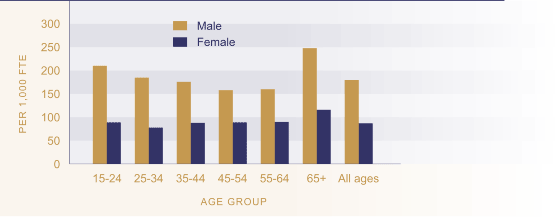Relevance
Safety at work is an important contributor to wellbeing and the risk of work-related accidents or illness can be seen as one component of the quality of work. The best currently available measure of the incidence of workplace injuries comes from the database of claims made to the ACC.
Current Level
By September 2002, 229,489 work-related injury claims had been reported to the Accident Compensation Corporation for injuries incurred over the year ended June 2002, an increase of 1,595 (0.7 percent) on the year ended June 2001. This represents a rate of 141 claims per 1,000 full-time equivalent employees (FTEs), about the same as the previous year (a rate of 144 per 1,000 FTEs). The majority of claims were for medical treatment only (ie not including weekly compensation). Eighty percent of claims were in respect of employees, and people who employed others in their own business. The remainder were the self-employed who did not employ others in their business. The incidence rate for the self-employed not employing others was twice that of the rest of the workforce, as defined above, (246 per 1,000 FTEs compared with 127 per 1,000 FTEs).
Information on workplace injuries for 2002 is based on a new set of indicators developed by Statistics New Zealand. These figures have been backdated to 2001 but are not directly comparable with previous figures on workplace injuries. A comparison of the general trend over time, however, shows the number of claims reported to the ACC was approximately constant between 1995 and 1997 and then fell up to 1999. Numbers have continued to decline since 1999 but it is difficult to conclude much from this because of differences in the methods of collection.
Figure PW4.1 Estimated claim rate per
1,000 FTE employed by age and sex, 2001-2002 
Source: Statistics New Zealand
Injury claims for the year ending June 2002 that had been reported by September 2002 included 85 work-related fatalities. This is likely to be an underestimate of the final number of fatalities, because some deaths may subsequently have occurred for injuries in that period, and not all fatal work-related accidents result in a claim to ACC. Agriculture accounted for 20 percent of work-related fatalities, followed by manufacturing (14 percent) and construction (13 percent).
Age and Sex Differences
Males are more than twice as likely as females to suffer workplace injuries involving an injury insurance claim (180 per 1,000 FTEs for males compared with 87 per 1,000 FTEs for females). This reflects in part male predominance in relatively dangerous occupations. Among males, the highest injury claim rate was for those aged 65 and over followed by those aged under 35. Among females, age differences in the injury claim rate were less pronounced.
Ethnic Differences
Workplace injury claim rates are higher for Māori (175 per 1,000 FTEs) than for other ethnic groups. This is likely to reflect the fact that Māori are disproportionately employed in industries and occupations that have high injury rates, such as forestry. In 2002, the next highest rate was that for Europeans (129 per 1,000 FTEs), followed by Pacific peoples (125 per 1,000 FTEs). The ‘Other’ ethnic group has the lowest accident claim rate (103 per 1,000 FTEs).
Table PW4.1 New workplace injury claims, by ethnicity, 2001/2002
| Ethnic group | Number of claims | Rate per 1,000 FTEs |
|---|---|---|
| European | 166,548 | 129 |
| Māori | 26,765 | 175 |
| Pacific | 9,533 | 125 |
| Other | 10,973 | 103 |
| Total | 229,489 | 141 |
Source: Statistics New Zealand (2003b)
Industry Differences
Variation in injury rates for different industries underlies many of the differences in injury rates for males and females, and ethnic and age groups. The highest injury rates are in mining (279 per 1,000 FTEs), agriculture (212 per 1,000 FTEs), construction (197 per 1,000 FTEs) and forestry (190 per 1,000 FTEs).
Table PW4.2 New workplace injury claims, by industry, 2001/2002
| Industry | Number of claims | Rate per 1,000 FTEs |
|---|---|---|
| Mining | 837 | 279 |
| Agriculture | 25,632 | 212 |
| Construction | 21,227 | 197 |
| Forestry | 1,902 | 190 |
| Manufacturing | 47,462 | 172 |
| Transport and storage | 9,969 | 142 |
| Hunting and fishing | 1,107 | 123 |
| Electricity, gas and water supply | 1,072 | 107 |
| Accommodation, cafes and restaurants | 6,490 | 100 |
| Wholesale and retail trade | 26,288 | 94 |
| Communication services | 2,613 | 84 |
| Health and community services | 9,788 | 73 |
| Education | 7,652 | 64 |
| Property and business services | 10,236 | 58 |
| Finance and insurance | 1,307 | 27 |
Source: Statistics New Zealand (2003b)
